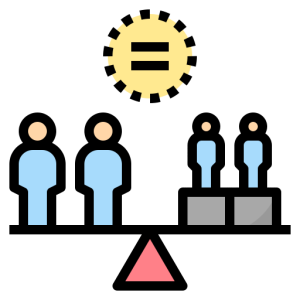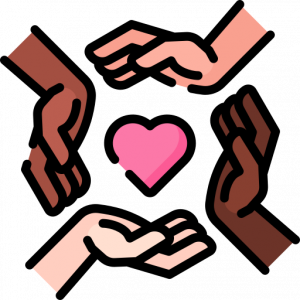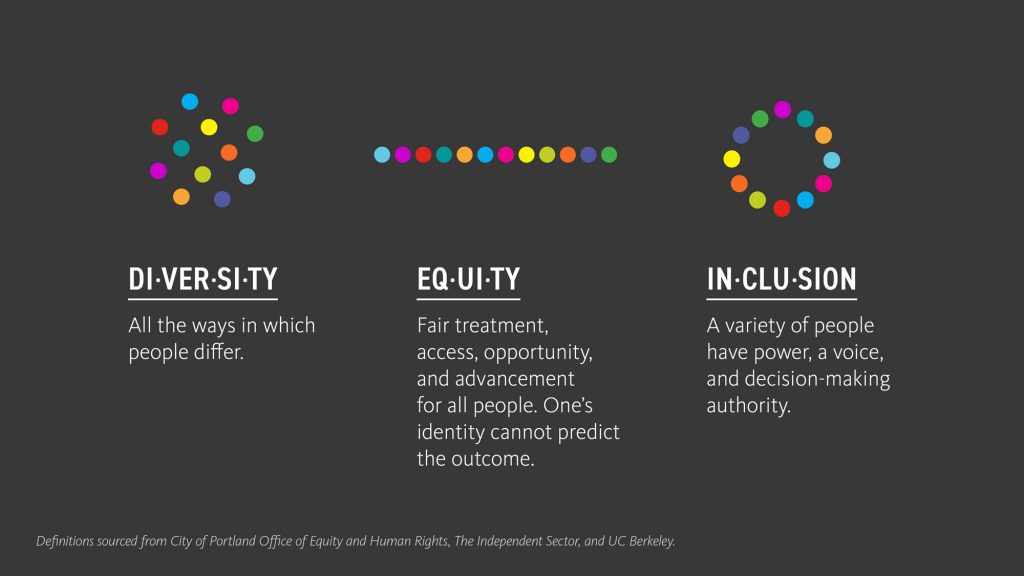1.4 Equity, Diversity, and Inclusion
EDI is an acronym that includes the three interrelated concepts of equity, diversity, and inclusion. When you think of these three words, what comes to mind for you? What do you notice? Do you notice differences, similarities, or relationships between these three words? Let’s first look at some formal definitions with examples and guiding questions for each of these terms.
Equity

We should first start with what equality is and what equity is, as the two concepts are often confused with one another.
- Equality generally means treating people the same way, to give everyone equal access to opportunities and benefits in society (see Figure 1.3).
- Equity begins with “the consistent and systematic treatment of all individuals in a fair, just, and impartial manner” (Executive Branch, 2023) (see Figure 1.2).
For example, in Figure 1.3 below, three people of different heights are trying to reach an apple on a tree. On the left, everyone is given the same height box to stand on, and as a result, only the tallest person can get an apple. This represents equality. On the right, each person is provided with a box that allows them to reach the apples—the shortest person has the tallest box. This represents equity.

Equity ensures that everyone has access to the same opportunities. Equity recognizes that privileges and barriers exist and that, as a result, we don’t start all from the same place. Rather, each of us comes from a different background. Equity begins with an acknowledgment of these unequal starting places and makes efforts to address this imbalance (Bolger, 2020).
Diversity

Now, take a minute to think about the diversity of your own team or organization. What do you think? How would your experience change if you were a different gender, sexual orientation, race, religion, or ability?
The definition of diversity used by the United States Census Bureau (2024) is: ‘identities, races, ethnicities, backgrounds, abilities, cultures, and beliefs of the American people” (see Figure 1.4).
Inclusion

As you work through the content below, think about how you might react if someone asked you, “What is your organization doing to become a more inclusive environment?”
Inclusion refers to taking into account differences among individuals and groups when designing something (e.g., a policy, program, curriculum, building, shared space) to avoid creating barriers. Inclusion is about people with different identities feeling or being valued and welcomed within a given setting (see Figure 1.5). As long-time DEI educator, Verna Myers (2018), puts it: “Diversity is being asked to the party. Inclusion is being asked to dance.”
What Equity, Diversity, and Inclusion Really Means

When examining these concepts together, we can say that equity is described as fairness, sameness, and appreciation of diversity and inclusion (see Figure 1.6). Diversity is often perceived to be about points of view, representation, and support of inclusion. Inclusion is about creating environments that are open to feedback, supporting diversity, and being transparent and flexible.
References
Bolger, M. (2020, May 24). What’s the difference between diversity, inclusion, and equity? General Assembly. https://generalassemb.ly/blog/diversity-inclusion-equity-differences-in-meaning/
“Executive order on further advancing racial equity and support for underserved communities through the Federal Government.” The White House, 16 February 2023, https://www.whitehouse.gov/briefing-room/presidential-actions/2023/02/16/executive-order-on-further-advancing-racial-equity-and-support-for-underserved-communities-through-the-federal-government/. Executive Order.
Myers, V. (2018, August 13). Vernā Myers Sizzle Reel Vimeo. https://vimeo.com/vernamyers/vernamyerssizzle
Ontario Human Rights Commission. (n.d.). Appendix B: Glossary. http://www.ohrc.on.ca/en/human-rights-and-policing-creating-and-sustaining-organizational-change/appendix-b-glossary
Portland, G. (2020). Inclusion by design: Insights from design week Portland [Blog post]. Gensler. https://www.gensler.com/blog/inclusion-by-design-insights-from-design-week-portland
Saskatoon Health Region. (2014). Equity vs Equality [Graphic]. https://www.nwhu.on.ca/ourservices/Pages/Equity-vs-Equality.aspx
United States Census Bureau. (2024). Diversity, equity, and inclusion. https://www.census.gov/about/census-careers/equity-inclusion.html
Attribution
This chapter contains material taken from Universal Design for Learning (UDL) for Inclusion, Diversity, Equity, and Accessibility (IDEA) by Darla Benton Kearney and is used under a Creative Commons Attribution 4.0 International License.

